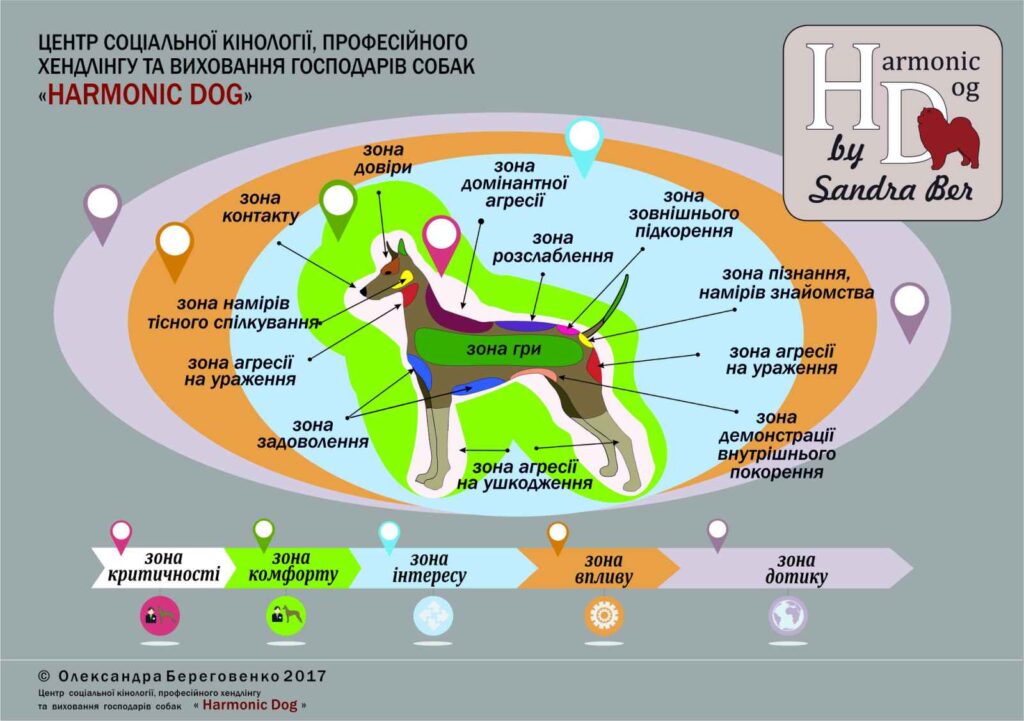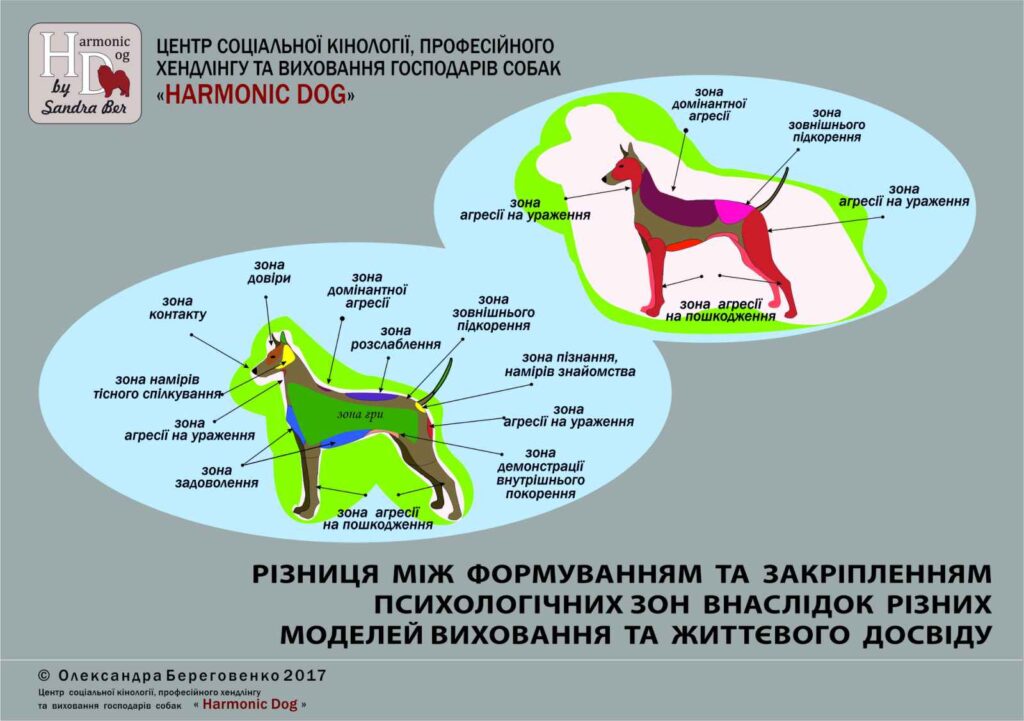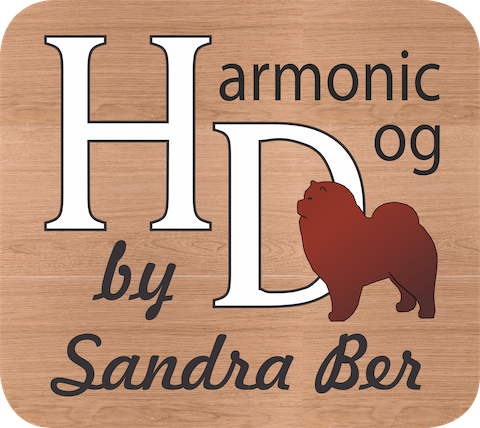Insert. I propose to cover another extremely interesting topic about the peculiarities of the dog’s vision: the psychological areas of the body and their importance in visual and tactile communication. The theme that we, people, need to know in order to feel better and understand those one who are around us.
As a member of the species, who is accustomed to live in packs, due to the need to develop active intraspecific communication, the dog has acquired and developed a large set of communication skills among its peers. At the same time, taking into account the peculiarities of natural habitats, where extra sounds are a danger for life or a threat to successful hunting, the dominant type of dog communication become not sound, but visual one.
Note: There is a big difference between our species in the main type of communication. The more humanity have been developing the awareness of the verbal communication, the more our brain was being rebuilt to the sound information’s processing as basic for humans, losing the ability to assess nonverbal and other types of communication, substantially degrading in these areas.
Naturally, people react differently to nonverbal cues: those who are still sensitive to them or have specially developed their skills have survived. Moreover, the vast majority are either unaware of this area, or have no experience at all in “reading” and deciphering the nonverbal communication signs.
Visual communication of canines operates with a wide range of signs, demonstrations of postures, body parts, signals and various behavioral patterns. In the evolution process of the information exchange through behavioral features, lifestyle, hunting and reproduction, the dog’s body parts, in addition to physiological, acquired certain psychological meanings. The dog’s body is able to be divided roughly into psychological zones. Touching or fixing them carries important information about the intentions and feelings of the “interlocutor”. In the same way, their demonstration is informative for others. This article I will start the seria of posts where I in details will tell about every psychological zone, its forming and sence, the age changing, the raising and targeted trainings.
For someone, these knowledges will radically change the world of interacting with a pet. For others – will be useful “puzzles” in understanding the behavior of dogs.
Pay attention! Non-verbal communication, as well as verbal communication includes feedback necessarily. This is real communication and mutual understanding. Just “contact”, what about it can be heard so often: “You need to find contact with the dog!”, “Make good contact”, “You do not have enough close contact” – this is, as they say, a conversation “about nothing”.
Keeping the dog on a leash, holding it in your arms, looking at it, saying commands, you already have different types of contact with it. However, this does not guarantee the appearance of two-way communication, when you understand each other correctly, and do not assess the state of the “interlocutor” at your own discretion according to the stereotypical interpretation. A simple example: sitting on a chair, you have formed a wonderful two-way contact with it, but there is not any communication here even close…
Absence of the verbal feedback accompanies or generates destructive relationships, misunderstandings, interrupts the desire to communicate and attempts to communicate, creates many conflicts and leaves only the relationship of “conqueror” and “dependent”, “addicted”. Dogs stop “talking” to whoever do not understand them. And, although most of our pets suffer from our ignorance and “blindness”, there are enough one who begin to use the ways people still react: aggressive warnings or even rude physical influence. Therefore, simple basic knowledges about the world through the eyes of the dog can dramatically change the relationship between people and their pets; raise them to a new, extremely interesting and high quality level.

Scheme № 1 indicates 12 informationally psychological zones of the dog’s body, divided into three subcategories:
– zones of aggression;
– zones of intentions and individual relationships;
– zones of play, fun and relaxation.
Besides the psychological zones directly on the dog’s body, there are so-called remote spaces around the personality: a space of criticality, comfort, interest, influence and touch. It depends on the individual development and fixation of these zones when your pet will visually begin to respond to various objects and situations, show attention to something, obvious interest, some discomfort or even stress, and demonstrate other types of behavioral reactions.
We will also talk about all this later.
Looking ahead, to explain the principles of formation and plasticity of the psychological zones, it is worth paying attention to some important features:
– differences in the formation, manifestations and demonstration of zones in relation to age and sex;
– basic fixation of zones in the early stages of socialization and the possibility of a complete change of instinctive reactions this time;
– general plasticity and ability to change during the life;
– the situational change of degree and the speed of reactions depending on the psychological zones;
– situational change of degree and speed of the psychological zones reactions depending on physical and psychological condition;
– thorough consolidation of reflex responses as a result of trainings and life experience.
In other words, each dog has its own “picture” of psychological zones, that depends on the circumstances and people who met in its life, on their knowledges and behavior.
And, of course, it is the breeders in the first 60-75 days after the puppy’s birth will lay the foundation for the degree, the type of reaction and activity of every zone. How they formed are, depends on their knowledges and targeted training: on relaxation and satisfaction or the patience and submission’s states. And, if necessary, how quickly and easily you can change the acquired reactions.
Pay attention! People often believe if the puppies were growed in a family with children who constantly “played” with them and took them in their arms, it becomes the guarantee of socialization and “love” for children. Unfortunately, as my practice shows, the opposite often happens: the process of children’s playing not controlled by adults causes more harm and tactile phobias in dogs than the benefits and correct communication skills.
The breeder must have a good understanding and knowledge of the principles of psychological zones’ formation to predict accurately the consequences of training or their absence, accounting the goals he is going to get in the puppy’s upbringing. It is also important to explain to potential owners the further principles of raising their pet and consolidating its faithful social reactions.

In scheme № 2 you can clearly see how active and differently developed psychological zones of the dogs as a result of the personal life experience or the targeted training.
For example: a working dog with its “psychological profile” will be significantly different from a socialized dog, who is accustomed to living in a family.
Let me pay your attention to another important feature of the worldview of our pets.
Naturally, the level of consciousness of dogs is far from ours, human, and is lower than the level of some other species of animals: higher primates, elephants, dolphins and more. But still the consciousness of dogs is quite developed.
The peculiarity of associative thinking is the rapid search for similarities among the information that the brain already operates. Therefore, from the point of the dog’s view, our hands, according to the associative set of signs, are more a subspecies of teeth than paws.
Appreciate yourself: “Can a dog fix something in its teeth and lift it up?” –”Yes”; “Can he do the same with one paw?” – “No”. In contrast, a person can lift something with one hand as easily as a dog with teeth. Next: “Can a dog move something in its teeth for a certain distance?” – “Definitely”; “And do the same with its paw?” – “Exactly not”. At the same time, it is not a problem for a person to carry something with the help of hands; “Does a dog walk on the ground with its paws?” – “As we do it with our legs. But neither the dog nor we lean on the ground with our teeth while moving”.
The associative logic for a dog is simple: everything we do with our hands, the dog perceives as the thing is done with its teeth.
However, there is a big difference in assessment between actions: to pet with the hand – to lick with the tongue, to pat – to bite, to get ours hands – to fix with the teeth. Do not forget: we are primates.
It is typical for us, as for the species and type, to hug, hug each other, clap, kiss. Rather, it is an expression of friendship, positive attitude or even love. For dogs, without special socialization training, this manner of communication – an unpleasant psychological pressure, threats and even direct physical aggression.
This is what becomes the cause of many conflicts and bites of both children and adults, when they hug their necks, clap or pat them on the back, kiss the dog. From the dog’s point of view, this looks like people’s unmotivated aggression. Therefore, the dog has every reason to respond you defending.
We return to our main topic and the “zone of the dominant aggression”, what around most myths and mistakes in education, which then expensive for both owners and their pets are cost.
The main tasks of evolution: to survive and improve. Aggression is one of the most attractive selection tools of nature. It plays an important and necessary role as inside the species so in interspecific interactions.
In the wild nature, where there are no vets or pills, the results of direct physical aggression and injury are mostly fatal. To keep the useful role of aggression in intraspecific selection, but without loss of population while this process, the nature has found a way to minimize the possible negative consequences by creating so-called ritual aggression.
Ritual aggression is a demonstration of physical and psychological power to defeat the enemy, but with minimal physical damage on both sides. In other words, it is a “mental” fight, which purpose not to kill, but to gain the submission. Of course, even the ritual aggression do not always keep completely contactless. Equally, there will be injuries and damages from time to time, especially if the opponents are equal in strength, status and perseverance.
To avoid serious physical traumatization, evolutionary processes “delineated” the psychological “zone of dominant (ritual) aggression” on the dog’s body – the neck and the dog withers (see scheme № 1). What is the peculiarity of this part of the body from a physiological point of view? Why did nature “choose” it here, and not the paws or throat, waist or sides?
The basic “logic”: physical injuries of this place are not as traumatic and dangerous for survival as the other parts of the body.
The neck and withers in dogs – a place where:
– there are no large blood vessels, which damage threatens death from severe blood loss;
– there are no internal organs, which injury is extremely dangerous to health;
– There is a lot of muscle tissue in this place, the most part of them is short muscles directed in different directions, well covering the bones from direct damage;
– right here the dog has the thickest and the most elastic skin, rough and thick fur, many breeds even have a developed “mane”;
– the length of the spinous processes of the vertebrae in the withers area significantly complicates the access of the enemy’s teeth to the spinal cord;
– damage to the shoulder blade near the withers – an unpleasant injury, but also not critical to the general dog condition in contrast to damage to the paws.
All this together makes it possible for the “zone of dominant aggression” to affect minimally on the vital functions of the organism as a whole. The animal retains the ability to hunt and defend.
Thus, every touch to the “zone of dominant aggression” is evolutionarily set out the instinctive information about aggressive intentions on the other creature part. But not aggression related to the desire to kill the enemy, but ritual intraspecific, often sexual, to demonstrate their strength and make its submission. If the dog aims to kill the enemy – it will not bite at the withers or neck, and will make every effort to reach the “death zones”: throat and groin. As a last resort – will focus on the paws.In addition, a sharp shock to the withers activates the release of a number of hormones, including high doses of adrenaline. This is sometimes used in working training: when the dog receives a command from the handler to attack, the trainer or owner makes additional sharp punches with his/her fingers or hand on the dog’s withers, stimulating the pet to increase attack speed, toughness and willingness to fight a stronger enemy.
Pay attention! The strength and type of toughing to “the zone of dominant aggression” indicates only the strength of ultimate intentions. But the basic information does not change because of that. Dogs remain typical representatives of canins, despite of millennia of living next to humans.
Only the right targeted training can change the natural reactions to others, we need in an usual everyday life with a dog.
And now let’s look at everything from another angle.Given the anatomical structure of human as a straight-walking creature, where do we usually go in an effort to pet a dog? What do we touch in the first place, leaning (hanging) over our puppies? (We will also talk in detail about the “zone of trust” – the dog’s forehead). Where does a child most often touch while the contact with a dog? How to put a hand over a pet? How often do we “kindly pat on the withers”, expressing our positive emotions? How do we hug and hold our pet tightly in love, throwing our hand on top? What do we fix, hugging his neck?
And only because our four-legged pets are extremely conflict-free, ready to tolerate human ignorance and mistakes to the last, demonstrating submission and a desire to avoid the conflict, people rarely guess the true feelings and intentions of the dog.Ears pushing back, licking, squinting, a “smile” on the snout, a lowered head, a lowered, rapidly swaying tail, a hunched back, stepping from paw to paw, a quick turn on the back with a fading and a demonstration of the abdomen – a person interprets usually incorrectly for signs of pleasure. In fact, the dog is trying to demonstrate us its submission by all available visual ways, hoping to stop your demonstration of aggression and psychological pressure. The worst thing is that by repeating such actions day after day, months and years, we unconsciously create one of the most difficult chronic stressful situations.
The dog Does not understand what causes such behavior of a person, what wrong has it done, what should it do in the future to avoid the unwanted? Feeling confused and scared when people show aggression instead of desire to communicate positively? Doesn’t realize why children are allowed to disregard the norms of family relations, and the family leaders do not stop their aggressive actions?
The half trouble, if the touching to the withers – that is smooth petting movements. And if the owner likes to sharply “shake” and “squeeze” a four-legged friend? Or a small child grab the puppy by the back, trying to lift it off the floor and pick him up? Who is responsible when a volunteer with the best intentions hugged a dog by the neck for a beautiful promotional photo, and the dog growled and pulled away? Is it any wonder when a vet grabs a patient by the withers to give an injection and the dog shrugs and demonstrates its teeth?
As a result, demonstrating aggression the first; we get constant stress, submission, chronic psychological blocks, loss of confidence, the formation of fear and exclusion and the formation of antisocial behavior. And we get a high possibility of direct or redirected aggression in response to those moments when the dog no longer does not want or can tolerate.
Remember: if dogs in there own family are accustomed and willing to put up with this “manner of communication”, but they are not obliged to tolerate others and have an absolute right to give proportional respond.
There is a myth a mother-bitch takes a puppy by the withers while moving it from place to place. In fact, this is another fabrication, an attempt to justify the people actions because of our ignorance. Or someone has confused it with the cats behaviors, who take the kitten in there teeth by the withers, causing fading and relaxation. In contrast with dogs, their species gives a completely different psychological reaction to fixation the withers with the teeth – “zones of extinction and submission”.
An adult dog tries to take the puppy by the shoulders or body with it whole mouth – very carefully so as not to harm either physically or psychologically. Inexperienced young bitches can sometimes take the pup carelessly, but change the position at the first puppies cry. Experienced bitches do everything so delicately that the puppy does not even strain.
Dominant ritual aggression has clear, well-defined causes. It is a struggle for a sexual partner or hard intraspecific submission outside of family relationships. In all other cases, it is estimated as inappropriate provocative behavior, the dog has every right to respond to the offender.
Therefore, when you take a dog by the withers, lift it, turn it over and press it to the ground, while shouting “Yuck”, You can’t” – remember: in the dog eyes you are an extremely inadequate creature, who without any reason and motive shows aggression towards a weak puppy!Next time we will talk about the so-called “zone of the trust” and “zone of the contact”.
Oleksandra BEREHOVENKO, Head of the social cynology, professional handling and dog owners educational Center “Harmonic Dog”
